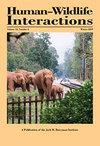石貂和红狐在两种不同活陷阱中的应激反应
IF 0.9
4区 环境科学与生态学
Q4 BIODIVERSITY CONSERVATION
引用次数: 0
摘要
诱捕陆生动物是全世界收获、虫害防治和研究的重要工具。为了活捉动物,必须确保动物福利,这体现在主权国家之间关于动物贸易和诱捕的不同协议中(理事会条例[欧共体]No 3254/91)。红狐(Vulpes Vulpes)和石貂(Martes foina)是重要的掠食性动物。它们对受保护物种的影响,以及它们在城市地区日益增多的出现,都需要负责任的处理。在我们的研究中,我们根据国际人道诱捕标准协议(AIHTS)和国际标准化组织10990第5部分-限制陷阱测试方法(ISO 10990)规定的标准评估了两种用于诱捕红狐和石貂的陷阱系统。在德国石勒苏益格-荷尔斯泰因,我们用混凝土管顶陷阱捕获了20只红狐,用斯特拉克的木箱陷阱捕获了13只石貂,并观察了它们在每个陷阱中的行为。麻醉后,对每只动物进行临床检查,并采集血液和毛发样本。安乐死后,对全身进行放射学检查,并进行尸检和组织病理学检查。未发现陷阱相关病变。根据最先进的方法,激素分析显示动物没有明显的压力迹象。除血清皮质醇外,血清和毛发中的脱氢表雄酮商似乎是两种不同物种应激反应的最具预测性的值。对被困动物的视频观察成为通过行为来评估动物福利的一种有价值的工具。这项研究补充了AIHTS和ISO 10990标准的行为和激素分析结果,在评估每个诱捕系统的动物福利时是一个额外的好处。本文章由计算机程序翻译,如有差异,请以英文原文为准。
Stress Response of Stone Martens and Red Foxes in Two Different Live Traps
Trapping of terrestrial animals is an important tool for harvest, pest control and research worldwide. To catch animals alive, animal welfare has to be ensured, which is reflected in different agreements on trading and trapping of animals between sovereign nations (Council Regulation [EEC] No 3254/91). The red fox (Vulpes vulpes) and stone marten (Martes foina) represent important predatory animals. Their influence on protected species as well as their increasing appearance in urban areas demand responsible handling. In our study, we evaluated 2 trap systems used for trapping red foxes and stone martens in accordance with criteria stipulated in the Agreement on International Humane Trapping Standards (AIHTS) and International Organisation for Standardisation 10990 Part 5 – Methods for Testing Restraining Traps (ISO 10990). In total, we captured 20 red foxes in a concrete pipe vault trap and 13 stone martens in a Strack’s wooden box trap in Schleswig-Holstein, Germany, and observed their behavior inside each trap. After anesthesia, a clinical examination of each animal was conducted, and blood and hair samples were taken. After euthanasia, radiological examinations of the full body were taken, and necropsies and histopathological investigations were performed. No trap-associated lesions were found. Hormone analysis showed no remarkable signs of stress for the animals, according to state-of-the-art methods. Apart from serum cortisol, the quotient of dehydroepiandrosterone in serum and hair seems to be the most predictive value on stress response of the 2 different species. Video observation of the trapped animals emerged as a valuable tool to estimate animal welfare by behavior. This study complements AIHTS and ISO 10990 criteria with results on behavior and hormone analysis, being an additional benefit when evaluating animal welfare of each trapping system.
求助全文
通过发布文献求助,成功后即可免费获取论文全文。
去求助
来源期刊

Human–Wildlife Interactions
Environmental Science-Nature and Landscape Conservation
CiteScore
2.80
自引率
0.00%
发文量
0
审稿时长
11 weeks
期刊介绍:
Human–Wildlife Interactions (HWI) serves the professional needs of the wildlife biologist and manager in the arena of human–wildlife conflicts/interactions, wildlife damage management, and contemporary wildlife management. The intent of HWI is to publish original contributions on all aspects of contemporary wildlife management and human–wildlife interactions with an emphasis on scientific research and management case studies that identify and report innovative conservation strategies, technologies, tools, and partnerships that can enhance human–wildlife interactions by mitigating human–wildlife conflicts through direct and indirect management of wildlife and increased stakeholder engagement. Our intent is to promote a dialogue among wildlife professionals concerning contemporary management issues. As such, we hope to provide a repository for wildlife management science and case studies that document and share manager experiences and lessons learned.
 求助内容:
求助内容: 应助结果提醒方式:
应助结果提醒方式:


